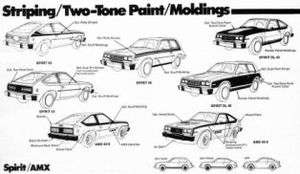Trim level (automobile)
_LX_sedan_rear_(cropped).jpg)
Trim levels are used by manufacturers to identify a vehicle's level of equipment or special features.[1][2][3] The equipment/features fitted to a particular vehicle also depend on any options packages or individual options that the car was ordered with.
Usage
For a given car model, the trim level denotes which equipment and features are included as standard. A car buyer may add to this standard equipment with trim packages or individual options. The trim level with the least equipment/features is referred to as the "base model",[2] and the trim level with the most equipment/features is referred to as "highest specification" or colloquially as "fully loaded". Differences between trim levels often consist of interior equipment (eg leather seats and reversing cameras), and cosmetic changes;[2][3] however sometimes a trim level can include mechanical changes such as different engines, suspension or all-wheel drive systems.[4][5]
Some car brands use a different car model for what could be instead considered a trim level, therefore the distinction between a model and trim level can vary between brands. For example, Volkswagen could choose to market the Golf GTi either as a standalone model, or as a trim level within the Golf model.
Naming systems
Trim levels are often designated by a pair of letters, for example DX, LX, LS, EX, GL, SE or GT.[1] They can also be designated an alphanumeric code (eg Z28, XR5, GT3), or using a word (eg Executive, Ambition or Deluxe).
In North American, long-running designations for high-performance trim levels include Chevrolet's "SS" for (first introduced on the 1961 Impala)[6] and Ford's "GT" (first used on the 1965 Mustang).[7][8] General Motors also use alphanumeric coding to denote handling packages installed on performance vehicles, such as "Z28" on the Camaro, the Buick GS, or the Oldsmobile 442, and currently uses the designation "Z71" on the Suburban and Tahoe.
During the 1970s and 1980s, some manufacturers used the same word for the highest trim level on several models, for example Nissan used the word "Brougham" as the highest trim level on both the Cedric[9][10] and Gloria.[11]
Options packages

Manufacturers sometimes sell bundles of options as an options package, usually at a discounted price compared with buying each option individually.
Common options packages currently include:
- Trim/appearance package: May include special paint colours, upgraded interior trim pieces (often made from aluminium, chrome or timber) and exterior decals. In past decades, appearance packages have also included two-tone paint, pin striping, bumpers painted the same color as the vehicle body, and vinyl roof covers.
- Sports/performance package: May include engine upgrades, handling upgrades (see below), a more aggressive front spoiler, a rear wing, upgraded brakes, and a limited slip differential. In an SUV or light truck, a sports package may consist of racks or tiedowns for transport of off-road recreational vehicles and other equipment.
- Towing package: May include heavy duty radiator, larger cooling fans, extra transmission cooling provisions, and revised axle gearing.
- Safety package: May include seat belt pre-tensioners, additional air bags, collision avoidance system (AEB), electronic stability control and adaptive headlights.
- Handling package: May include stiffer springs, stiffer shock absorbers, stiffer anti-roll bars, larger/lightweight wheels or higher grip tires.
- Navigation package: Satellite navigation, often with turn-by-turn instructions
See also
References
- 1 2 "Trim levels 101: All about trims, styles, options and packages". www.edmunds.com. Retrieved 31 March 2018.
- 1 2 3 "How to Choose New-Car Trim Levels and Options". www.autotrader.com. Retrieved 31 March 2018.
- 1 2 "Your vehicle's trim level: What it is, why it's important, and how to find it". www.tirebuyer.com. Retrieved 31 March 2018.
- ↑ "2017 Ford F-150 trim level comparison". www.mikecastruccifordmilford.com. Retrieved 31 March 2018.
- ↑ "Ford Focus Sedan and Hatchback Models". www.brandonford.com. Retrieved 31 March 2018.
- ↑ "Chevrolet Impala SS History 1958-1969". Archived from the original on 2013-10-23. Retrieved 2014-05-08.
- ↑ "1965 Mustang History". www.themustangsource.com. Retrieved 31 March 2018.
- ↑ "1965 Ford Mustang". www.mustangevolution.com. Retrieved 31 March 2018.
- ↑ "1977 Nissan Cedric 4Door Sedan 2800 Brougham". www.automobile-catalog.com. Retrieved 31 March 2018.
- ↑ "Project Car Hell, Possibly Legal Japanese Import Edition: Nissan Cedric Brougham VIP or Toyota Corona GT-R?". www.autoweek.com. Retrieved 31 March 2018.
- ↑ "The Cedric and Gloria Series". www.datsunhistory.com. Retrieved 31 March 2018.